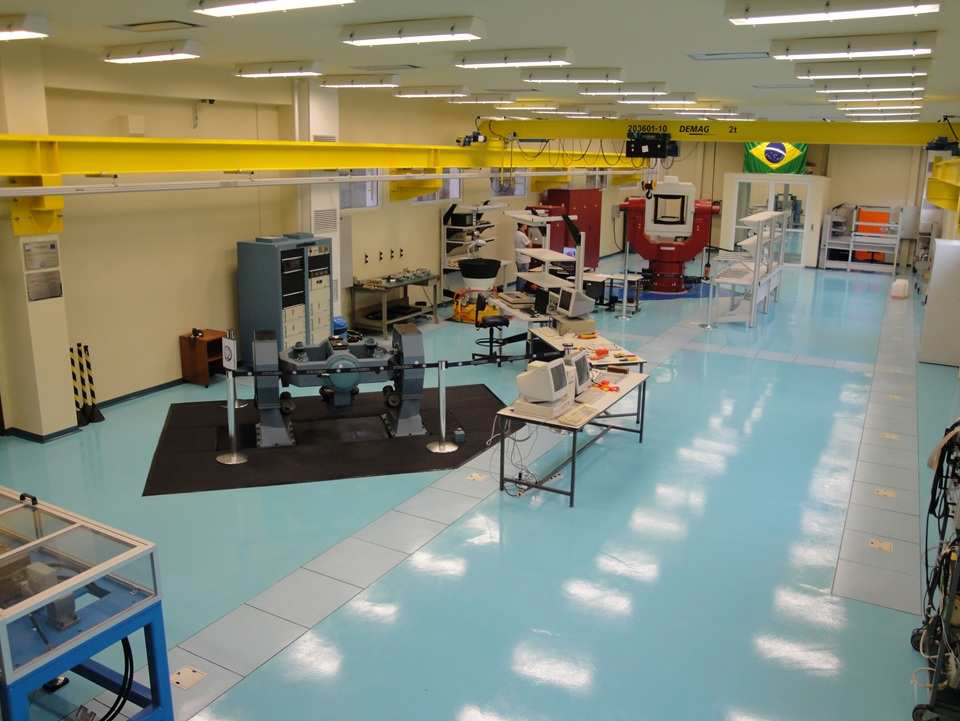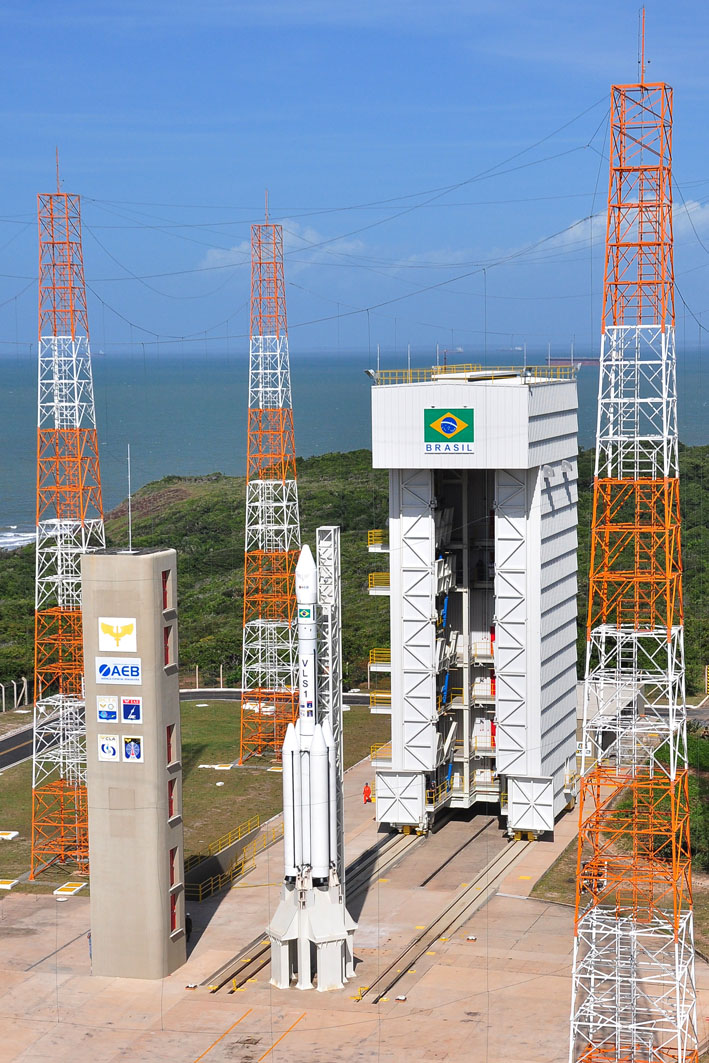- Detalhes
The project SPD (Propulsion System for Defense) is a fully national development of an aeronautical gas turbine led by DCTA, IAE, ITA and by TGM Turbines Company.
The project is funded both by FINEP and by TGM Turbines Company and consists of a turbojet engine with its applications intended for unmanned aerial vehicles.

- Detalhes
VS-40 is a two-stage rocket that is stabilized aerodynamically. The first stage and second stages carry 4,200 kg and 810 kg of solid propellant, respectively. It is capable of carrying a 500 kg payload to 640 km, providing about 12 minutes of microgravity. It consists of the third and fourth stages of the Brazilian Satellite Launcher Vehicle (VLS-1), under development by IAE. Initially VS-40 was developed to test under vacuum conditions VLS-1 fourth stage, the S44 engine, made of composite material. So far, two VS-40 were launched from Brazil (1993 and 1998) and another from Norway (2012), carrying the Shefex 2 payload. The fourth VS-40 flight is expected to occur soon, carrying SARA´s 300 kg payload to an apogee of 189 km. For this flight the S44 motor will carry inert propellant.
| Stage | 1st | 2nd |
|---|---|---|
| Motor | S40 | S44 |
| Lenght (mm) | 5,680 | 1,710 |
| External Diameter (mm) | 1,007 | 1,009 |
| Propellant Mass (kg) | 4,244 | 810 |
| Structural Mass | 1,1194 | 156 |
| Average thrust in vacuum (kN) | 254 | - |
| Burning time (s) | 37 | 58 |
| Action time (s) | 50 | 62 |
| Specific Impulse in vacuum (N.s/kg) | 2,642 | 2,770 |
| Total Impulse in vacuum | 11,400 | 2,250 |
VS-40 – VEHICLES & CAMPAIGNS

VS-40 PT-01 - "Operation Santa Maria" - 04/02/1993 - Flight Qualification for the S44 engine. 760s in micro-gravity conditions.
- Payload:Reentry Satellite
- Payload mass: 197 kg
- Apogee: 250 km
- Range: 200 km
- Time of microgravity: 300s
- Launch Center: Alcantara, MA, Brazil (CLA)
- Impact point: Atlantic Ocean

VS-40 PT-02 - "Operation Livramento" - 03/21/1998 - payload VAP-1 (Fokker).
- Payload:VAP-1 (Fokker)
- Payload mass: kg
- Apogee: 250 km
- Range: 200 km
- Time of microgravity: 300s
- Launch Center: Alcantara, MA, Brazil (CLA)
- Impact point: Atlantic Ocean

VS-40M / SHEFEX II - 22/06/2012 - payload SHEFEX (Sharp Edge Flight Experiment) II.
- Payload: SHEFEX 2
- Payload mass: 707.9kg (incl. Motor adapter and fairing)
- Apogee:176 km
- Range: 800 km
- Reentry Mach number: 11
- Launch Center:ARR (Andoya Rocket Range)
- Impact point: Atlantic Ocean, off the shore of Svalbard

40M / V03 - under development - SARA (Satellite Atmospheric Reentry)
- Payload: SARA (Atmospheric Reentry Satellite)
- Payload mass:300 kg
- Apogee:189 km
- Range: 298 km
- Time of microgravity: 300s
- Launch Center:Natal, RN, Brazil (CLBI - Launch Center Barreira do Inferno)
- Impact point: Atlantic Ocean
- Detalhes
The objective of Project L75 is developing a liquid propellant rocket engine with liquid oxygen and ethanol as propellants, turbopump fed and capable to generate 75 kN of thrust in vacuum. The purpose of such engine is to be part of an upper stage of any satellite launch vehicle, including VLS-Alfa and VLS Beta.
The project began in 2008. In 2011, a meeting was held for its Preliminary Design Review. In 2012, an agreement was signed between the Brazilian Space Agency (AEB) and the German Space Agency (DLR) for cooperation in the development and testing of the L75 engine. In 2013, an agreement between Fundação de Desenvolvimento da Pesquisa (FUNDEP) and AEB took effect to support the project.

L75 engine Mock-up
- Detalhes
The project SIA - Inertial Systems for Aerospace Applicationaims to develop and integrate prototypes of inertial navigation systems for aerospace application withparticipation of domestic industry. The main goal of the project SIA is dominate the technologies for the production ofinertial systems employing fiber optical gyros. Due to thedual nature of this item, it can be employed in other areas,the demand for which is much higher than the space.
In 2011, the implementation of laboratory infrastructure inIAE was completed with the opening of LINCS - Laboratoryof Identification, Navigation, Control and Simulation. In August was held important test Dynamic Inertial Navigation System (SISNAV).

LINCS - Laboratório de Identificação, Navegação, Controle e Simulação.
- Detalhes

MAIN OBJECTIVE
The VLS-1 main purpose is to accomplish a full technological flight, being capable of delivering with low eccentric equatorial circular orbit, low inclination, a satellite at 750 km, mass 200 kg.
RATIONALE
A After the conclusion of this Project, Brazil will have accomplished autonomously all steps related to the development of a Satellite Launch Vehicle, including design, manufacturing, launch, control, stabilization and delivery of a payload in Earth Orbit, fulfilling the short term goals of the National Program of Space Activities – PNAE and of the National Strategy of Science, Technology and Innovation.
VLS-1 DESCRIPTION
The VLS-1 is composed of four solid fuel propulsion stages, and it belongs to the class of small launchers. It has the nominal capability of delivering a satellite of 100 to 380 kg, over a range of 200 to 1,200 km in equatorial circular orbits; or of 75 to 275 kg over a range of 200 to 1,000 km in polar circular orbits.
The VLS-1 is integrated in seven major subsystems: 1st Stage, 2nd Stage, 3rd Stage, 4th Stage, Fairing, On-board Electrical Network and Pyrotechnical Network.
Physical Characteristics:
- Number of Stages: 4;
- Total Length: 19 m;
- Motor Diameter: 1 m;
- Take off Mass: 50 t;
- Type of Propellant: sólido compósito.
HISTORICAL FACTS
Milestones:
- 1980: Creation of the Brazilian Complete Space Mission (MECB);
- 1984: First conceptual reviews, at Centre Nationale d´Etude Spaciales (CNES);
- algoritmos de controle mais avançados;
- 1986: Second conceptual reviews ,at CNES;
- 1987: first ground test of S43 Motor;
- 1988:Preliminary Design Review, at CNES;
- 1994: Design Review, Salyut Design Bureau (SDB);
- 1997: First prototype launch – V01;
- 1999: Second prototype launch – V02;
- 2003: Accident on pad during launch preparation – V03;
- 2004: Redesigns and beginning of the Critical Design Review;
- 2011: New launch pad system and tower ready for operations;
- 2012:Physical integration of VLS-1 mockup to the new tower for functionality tests.
The VLS-1 is the first Brazilian satellite launcher. Its development is being possible thanks to more than 25 years of DCTA/IAE and national industry experiences related to suborbital rocket technologies.
Up to now, three VLS-1 prototypes were assembled and two lift-offs were accomplished from the Alcantara Launch Center (CLA). The V01 and V02 launches, named Mission Brazil in 1997 and Mission Almenara in 1999, respectively, made it possible to verify the in flight functionalities of several subsystems, such as:
- The first stage motors burned effectively,
- The stages’ attachments supported all structural loads during atmosphere critical
- The fairing held the thermal and structural loads;
- The on-board electrical network kept its functionality during all fight;
- The Thrust vector actuators worked adequately;
- The control system kept the rocket on track even under adverse conditions, for both prototypes.
However, for these two prototypes, due to technical problems, the missions could not be entirely completed.
In 2003, Mission Sao Luis, the third prototype was on pad in preparation for launch. In August 22nd, during on ground routine tests, there was an unexpected ignition in one of the motors, resulting in catastrophic accident.
After this accident with the V03 prototype, the VLS-1 was submitted to a comprehensive review. Several technical modifications and even some system redesigns were imposed by the detailed after-the-fact analysis. The on-board electrical and pyrotechnical networks were completely modernized.
PROJECT OUTCOMES AND SPINOFFS
- High strength steel production capability. knowledge is being used by automotive and aeronautical industry;
- Technology in composites and synthetic filament winding, used for pressure vessels;
- Production of high temperature resistant composite structures;
- Manufacturing and production of solid fuel;
- Design and development of onboard computers and command and control networks for space vehicles;
- Large facilities and laboratories for development and tests of space systems and components;
- Human resources in all areas of space programs, including management and technical workforce for design, structures, aerodynamics, flight mechanics and tests;
- Development of Inertial Measurement Unit for orbital vehicles;
- A functional and optimally located Launch Center;
- Excellency in suborbital rockets, with several exported vehicles;
- Capability of accomplishing complex space related missions.
NEXT STEPS 2013-1016
MIR – Electrical Network Integration Mockup for qualification of onboard components and systems:
- Full integration of the vehicle to the launch pad;
- Functional tests of telemetry, control, pyrotechnics, flight termination and support networks, for in flight qualification;
- Electromagnetic Interference and Compatibility (EMI/EMC) tests of all vehicle systems;
- Interface tests between the VLS-1 and all out board systems, wirings and connections, such as: telemetry data acquisition, control pad, flight termination protocol, fire line, tower, umbilical connectors, communication, etc.
VSISNAV – In flight qualification for (first and second stages will be active):
- Navigation Inertial Measurement Unit – SISNAV, in launch vehicle;
- Pyrotechnical network shock absorber systems;
- Separation event between first and second stages;
- Flight termination system;
- Stability of the S-43 Motors burn under acceleration;
- Telemetry acquisition data system;
- The new launch complex, including tower, control pad, shelter, support preparation buildings;
- Real time tests of Control Center, Radars, Telemetry, and Remote Stations of CLA – Alcantara Launch Center, CLBI – Barreira do Inferno Launch Center, and EMT, Telemetry Mobile Station.
XVT-02 – In flight qualification of a complete vehicle, with:
- All stages will be active and all functionalities will be tested;
- Full architecture Electrical Network, with closed loop;
- Domestic onboard computer;
- SISNAV as the vehicle primary inertial measurement system;
- Roll system and orbit stabilization;
- Orbit insertion of a technological payload.
V04 – Type Certification, full mission:
- Prototype aiming satellization;
- All on board systems based on the final XVT-02 configuration;
- Insertion of a Brazilian Satellite in Earth circular equatorial orbit.
Fostering of the national industry. Development of Brazil
- Detalhes

Diretor: Brig Eng Leonardo Magalhães Nunes Da Silva

Chefe: Glória Regina Esteves de Lira

Chefe: Chefe: Paulo Marinho Falcão - Cel R1

Vice-Diretor: Avandelino Santana Junior - Cel Av

Chefe: Chefe: Elymar Guimarães Fonseca Junior - Cel Av

Chefe: Antônio Carlos Ponce Alonso - Cel Eng

Chefe: Avandelino Santana Junior - Cel Av

Chefe: Chefe: Elymar Guimarães Fonseca Junior - Cel Av
DIVISÕES DO IAE

Chefe: Cláudio Martins de Oliveira

Chefe:
GEORGE Shingi Fujita - Cel Eng R1
Chefe: Sérgio Costa

Chefe: FERNANDO Luiz Ferreira de Azevedo

Chefe: PEDRO IVO Pinto Oliveira - Maj Eng

Chefe: Dr. Carlos Alberto Alves Cairo

Chefe: Abílio Neves GARCIA Ten Cel Eng

Chefe: João Pedro Caminha Escosteguy

Chefe: Thiago BRAIDO Nogueira de Melo - Cap Eng Aer

Chefe: Dr. Gilberto Fisch

Chefe: José Renato de Paula Souza

Chefe: Fernando César Monteiro Tavares - Cap Eng

Chefe: Valderci José Giacomelli

Chefe: Afonso Paulo Monteiro Pinheiro

Chefe: Dr. Rita de Cássia Lazzarini Dutra

Chefe: Alexandre Nogueira Barbosa - Ten Cel Eng











